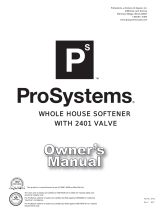
add 3 to salt amount for potassium, salt amount = 9 lbs. See programming section for your system
for instructions on changing the salt amount. Also keep the level of potassium in the brine tank
low.
D. Amount of Salt or Potassium
We recommend keeping the level of salt in the brine tank about half full for most households.
Larger households can start out with more. Let the salt level drop down to the water level before
adding more salt. Potassium should be kept as close to the water level as is practical to help
prevent a “salt bridge”. Periodically you may experience a salt bridge. A salt bridge occurs when
the salt forms a crust right at the water level in the brine tank. The salt remains suspended above
the water and cannot make the brine solution required for the regeneration of the softener bed. If
you do experience a salt bridge, simply tap a broom handle down in the salt to break up the bridge.
Wait at least 1 hour, and then manually regenerate the softener.
E. Cleaning the Brine Tank
Normally it is not necessary to clean the brine tank. In time dirt and silt can build up in the brine
tank and if you choose you can clean it out. Let the salt level drop down very low. The night
before you clean, manually regenerate the softener. Disconnect the brine line and dump out the
old salt, (Do not dump the old salt anywhere near living plants). Reconnect the brine
line, add about (3) gallons of water, and add the new salt.
F. Changing the Control Valve Settings
It is not necessary to change the control valve settings other than the ones described in step (6).
Over the course of several months it is possible the display will not show the correct time of day
due to power fluctuations. Reset the control to the correct time of day. If your feed water
hardness changes, reset the control to the new hardness. Other settings are programmed at the
factory for optimum efficiency and do not need to be changed.
G. Sodium and Potassium in Softened Water
The softening process does add some sodium or potassium to the conditioned water. The
following chart shows approximately how much sodium or potassium is added to one quart of
conditioned water based on the amount of feed water hardness.
Sodium added to water from cation exchange softening
Sodium added to water from cation exchange softening
Sodium added to water from cation exchange softening
Initial feed water hardness
Sodium added by softening
Potassium added by softening
For comparison, (2) slices of white bread contain approximately 278 milligrams of sodium and (2)
cups of milk contain approximately 226 milligrams of sodium. One large banana contains
approximately 600 milligrams of potassium.
H. Bypassing the Softener
You may need to bypass the softener for service or if you do not want your household water to
pass through the softener. See the diagram in step (1) for instructions on bypassing the softener.
The instructions are also shown on top of the bypass valve. Make sure you depressurize the
system before performing any service or removing the softener. See the “WARNING” in the
troubleshooting section below.
I. Vacations or extended periods of non-use
It is not necessary to shut down the softener for periods of non-use equal to two-week to one-
month vacations. If however, you are a temporary resident and leave for periods of four to six
months, we recommend you shut the softener down. Put the softener in bypass and unplug it.
When you return you will need to start the softener up. Make sure there are approximately (3)
gallons of water in the brine tank, plug the softener in, and manually regenerate the softener.
J. Disinfection of the Water Softener
The materials of construction of the modern water conditioner will not support bacterial growth,
nor will these materials contaminate a water supply. However, during normal use, a conditioner
Form KPWS030905 Page 11 of 25






















